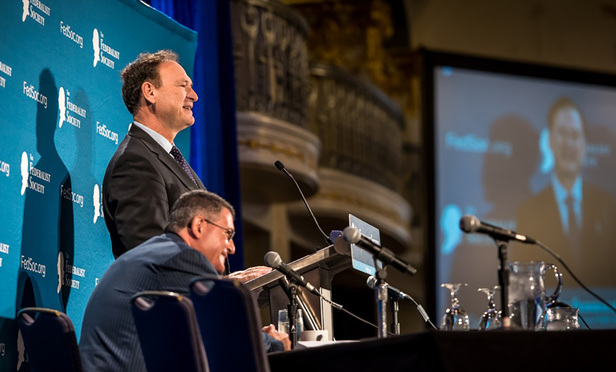 Justice Samuel Alito speaking at the Federalist Society 2016 National Lawyers Convention at The Mayflower Hotel in Washington, D.C., on Thursday, November 17, 2016.
Justice Samuel Alito speaking at the Federalist Society 2016 National Lawyers Convention at The Mayflower Hotel in Washington, D.C., on Thursday, November 17, 2016.
In the U.S. Supreme Court term that ended last June, Justice Samuel Alito turned to books most often to bolster his opinions, while Justice Anthony Kennedy—the court’s most influential voter—made least use of the wisdom embodied in books.
Justices cite books for a variety of reasons, Yale Law School’s Linda Greenhouse, a veteran high court observer, writes in “The Books of the Justices” in the latest Michigan Law Review.
The law review has an annual issue on books and asked Greenhouse to write for it.

Linda Greenhouse (2013). Photo: Diego M. Radzinschi / ALM
“I figured let’s see what the justices make of books so I embarked on this project over the months of keeping track of every citation to every book in every published opinion and kept them on index cards in a very low-tech, old-fashioned way,” Greenhouse said Friday.
In the October 2015-16 term, the justices cited 132 separate volumes, with 41 of the term’s 62 signed, published opinions containing citations to books, Greenhouse noted. For her analysis, she excluded certain types of reading material, such as government reports, the Congressional Record and the Model Penal Code.
The categories that the article examined ranged from treatises and practice manuals—the most cited at 51—to literature and modern primary sources, which were the least cited at five and three, respectively.
“Every justice cited at least several books during the term, with the exception of Justice [Antonin] Scalia, who cited only one book—Black’s Law Dictionary—in the four opinions he produced (two for the court and two in dissent) before his death in February,” Greenhouse wrote in her essay.
But Justices Clarence Thomas, Sonia Sotomayor, and Elena Kagan cited Scalia’s 2012 collaboration with Bryan A. Garner, “Reading Law: The Interpretation of Legal Texts.” In fact, Sotomayor and Kagan cited this book on opposite sides of the same case in Lockhart v. United States as they dueled over which canon of construction should be applied to the issue in the case.
Greenhouse theorized about why a justice—who generally would look to stare decisis, legislative history and case briefs for answers—would bother to cite a book. She suggests several possibilities:
A justice might want to “magnify the impact” of an opinion. Sotomayor is given as an example for her dissent in Utah v. Strieff, a Fourth Amendment challenge. In that dissent, the justice cited 10 books, most of which concerned African-Americans’ experiences with the criminal justice system. The books included classics such as W.E.B. Du Bois’ “The Souls of Black Folk” and the recent bestselling “Between the World and Me” by Ta-NeHisi Coates. Use of those books led to widespread coverage if her dissent in the media.
Treatises may be used to “surround a conclusion with presumably unimpeachable authority,” Greenhouse added. Thomas, she wrote, turned a “standard equity treatises” for his opinion in Montanile v. Board of Trustees of the National Elevator Industry Health Benefit Plan (2016). But they also may enhance a justice’s understanding of areas of law that they encounter infrequently.
A justice may turn to books to acquire information as Chief Justice John Roberts Jr. did in Sturgeon v. Frost for his unanimous opinion involving the Alaska National Interest Lands Conservation Act. He cited to a recently published history of that state and to a 1972 account of the gold rush.
And a justice may want to send a message to a specific audience by citing to a book, a kind of “dog whistle,” according to Greenhouse.
In his concurring opinion in the patent case, Cuozzo Speed Technologies v. Lee, which involved deference to the U.S. Patent and Trademark Office, Thomas cited a collection of essays, “Liberty’s Nemesis: The Unchecked Expansion of the State,” once again to call for overturning the well-known Chevron deference decision. The book, Greenhouse wrote, was edited by two conservative stars and was a selection of the Conservative Book Club.
“By selecting this particular book to cite, Justice Thomas was sending his base a strong signal of his sympathy and availability,” Greenhouse wrote.
Sometimes a purely literary reference is done simply to amuse.
Roberts, in Bank Markazi v. Peterson, turned to the American opera “Porgy and Bess” for this clever turn of phrase: “In reality, the court’s ‘plenty’ is plenty of nothing, and, apparently, nothing is plenty for the court.”
In the end, Greenhouse said her journey through the justices’ “bookshelves” during the last term raises as many questions as it answers.
“I have indulged the conceit that it was the justices, and not their law clerks, who selected the books to cite, in much the same way that we treat Supreme Court opinions as if the justices write every word of the opinions that bear their names,” she said. “In fact, the process for both is probably collaborative, rather than either/or. It’s hard to believe that rogue law clerks withheld dictionaries from Justice Kennedy or forced treatises on Justice Thomas. I assume that the patterns that emerged during OT 15, if not every citation in every opinion, reflect the justices’ actual preferences.”




